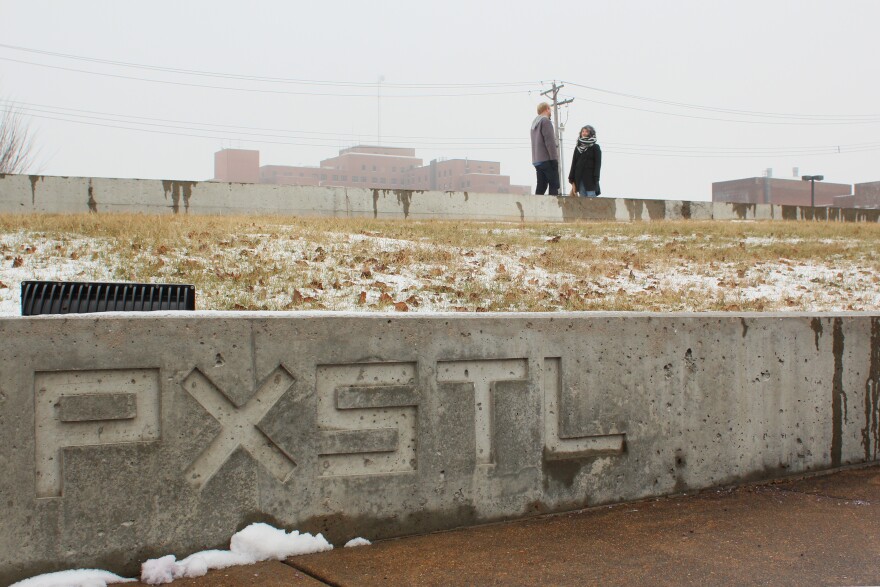UPDATE:
The Pulitzer Arts Foundation has announced the winners of its public art contest.
Architect Amanda Williams and artist Andres Hernandez will work with Sam Fox School of Design Students to build a structure on a temporary lot across the street from the museum.
The project will be completed sometime next year.
Original Story
Three designers are competing to develop a large scale art object to be installed on a vacant lot across from the Pulitzer Arts Foundation in Grand Center. The competition’s winner will work with the Pulitzer, students at Washington University’s Sam Fox School and city residents to develop the project.
Whoever wins, Cara Starke, the director of the Pulitzer, said the project hopes to break down barriers between the museum and visitors.
“Here is an opportunity, with PXSTL, to go beyond our walls, to move out into the community, and to engage space differently,” she said, “it’s one of the highlight projects for me in the coming year.”
PXSTL, a collaboration whose letters draw from Pulitzer, Sam Fox and St. Louis, aims, "to promote dialogue about urban life and the impact of environment on everyday experience," according to the Pulitzer website.
The Pulitzer’s last PXTSL project took place in 2014.
This year's competition calls "for a design-build commission to create a temporary structure, landscape strategy, or other design intervention that will transform a vacant lot into a site for community-based programming." It also includes a number of new elements, including an artist’s residency, a semester long teaching fellowship with the Sam Fox School, and additional student involvement.
Carmon Colangelo, the dean of the Sam Fox school, said the revised approach should give the winning designers a better understanding of the city and to increase the students' and the general public’s engagement with -- and commitment to -- the work.
“When they’re part of the design process, part of the building, part of the execution, they’ll be much more engaged and will have something in their portfolio in terms of experience and the chance to work with someone with international renown,” he said.
The project has attracted international attention. The three finalists hail from the Netherlands by way of Hong Kong, New York and Houston, and Chicago.
Merve Bedir and Jason Hilgefort came to the city a week ago to prepare for their presentation.
“I’m super happy that we are actually working on a methodology, a process, not a product. We are much more interested in working with people and investing in the capacity of communities,” said Bedir.
Higefort said the team was excited to work specifically on a project that both had an educational component and took place in St. Louis.
“Everyone knows St. Louis, but it’s a bit of a blank slate to me in terms of what it represents,” said Hilgefort, “and that potential of working on a place that everyone knows but is a bit of a blank canvas as a cultural reference is truly exciting.”
Bider and Hilgefort will compete with other artists, designers and educators Mary Ellen Carroll, Amanda Williams and Andres L. Hernandez. The design finalists will present proposals for the space at Washington University at 6 p.m., Mon., Feb. 15.
Examples of previous work by submitting designers:
Mary Ellen Carroll: Carroll's “No. 18 (The outside can never reveal what is happening inside)” examines Korean architecture. The artist rented the apartment in Korea and broadcast events inside the space to a nearby museum.

Amanda Williams and Andres L. Hernandez: Amanda Williams' project Color(ed) Theory (pictured below) asks the questions "What color is urban? What color is Gentrification? What color is privilege? What color is poverty?" through the action of painting abandoned buildings "culturally coded" colors. Andres L. Hernandez is an Associate Professor at School of the Art Institute of Chicago dedicated to using the arts as a "catalyst for community redevelopment in the city of Chicago."

Merve Bedir and Jason Hilgefort: This design team “collaborates on issues related to built form” and has worked on education, design, and research projects. They’ve been based out of the Netherlands but currently hail from China. Their designs have included proposals for hotels, re-designed mosques, and abandoned school buildings.









